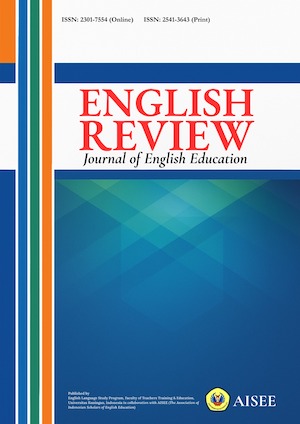PROMOTING READING ENGAGEMENT: THE SCHOOL LITERACY MOVEMENT AT JUNIOR HIGH SCHOOL 1 SEBATIK
Abstract
This study aims to analyze the indicators in the process of implementing the school literacy movement at junior high school 1 Sebatik and the obstacles faced. The research method used in this research is descriptive qualitative method. The data collection techniques used are observation, interviews and documentation. The results of this study describe that there are six indicators in the process of implementing the literacy movement at at junior high school 1 Sebatik, namely reading activities for 15 minutes, journaling literacy results, increasing interesting reading books, making literacy corners, conducting competitions that support the school literacy movement and making interesting libraries in support the school literacy movement. In addition, it was found that there were four obstacles experienced by at junior high school 1 Sebatik in the process of the school literacy movement, including: teachers have difficulty in carrying out literacy more than 15 minutes before class, teachers have difficulty providing digital books in class, teachers have difficulty in carrying out activities to respond to reading books, and teachers have difficulty in carrying out creative writing activities.
References
Abidin, Y. (2015). Pembelajaran Multiliterasi. Bandung: PT Refika Aditama.
Ahmadi, F., & Ibda, H. (2018). Media Literasi Sekolah: Teori dan praktik. CV. Pilar Nusantara.
Arikunto, S. (2006). Prosedur Penelitian Suatu Pendekatan Praktik,. Jakarta: Penerbit PT Rineka Cipta.
Creswell, J. W. (2010). Research Design Pendekatan Kualitatif, Kuantitatif, dan Mixed. Yogyakarta: Pustaka Pelajar.
Dalman, H. (2013). Keterampilan Membaca. Raja Grafindo Persada.
Gherardini, M. (2016). Pengaruh Metode Pembelajaran dan Kemampuan Berpikir Kritis Terhadap Kemampuan Literasi Sains. Jurnal Pendidikan Dasar, 7(2), 253–264.
Gunarsa, S. D. (1991). Psikologi Praktis: Anak, Remaja dan Keluarga. BPK Gunung Mulia.
Herman, H. (2020). Model Pembelajaran Berbasis Literasi di Madrasah. At-Tafkir, 13(2), 203–212.
Iskandar. (2009). Metodologi Penelitian Pendidikan dan Sosial (Kuantitatif dan Kualitatif). Gaung Persada Press.
Kemendikbud. (2017). Panduan Gerakan Literasi Nasional. Jakarta: Kemendikbud.
Kemendikbud, S. G. L. S. (2016). Desain Induk Gerakan Literasi Sekolah. Direktorat Jenderal Pendidikan Dasar Dan Menengah Kementerian Pendidikan Dan Kebudayaan.
Muhyidin, A. (2018). Reading Interest and Mastery of Foreign Absorbing Vocabulary (Minat Baca dan Penguasaan Kosakata Serapan Asing). Indonesian Language Education and Literature, 3(2), 143–156.
Nyoman, P. N., & Artini, L. P. (2018). Literasi Di Sekolah, Dari Teori ke Praktek. In Bali: Nilacakra.
Pahl, K., & Rowsell, J. (2012). Literacy and Education. SAGE Publications Ltd.
Purves, A. C. (1984). Chapter I: The Challenge to Education to Produce Literate Citizens. Teachers College Record, 85(5), 1–15.
Sugiyono. (2010). Metode Penelitian Kuantitatif, Kualitatif dan R&D. Bandung: Alfabeta.
Sutopo, H. B. (2002). Metodologi Penelitian Kualitatif. Universitas Sebelas Maret.
Ulfatin, N. (2013). Metode Penelitian Kualitatif di Bidang Pendidikan: Teori dan Aplikasinya.
Wiedarti, P., & Laksono, K. (2016). Panduan Gerakan Literasi Sekolah di Sekolah Dasar. Direktorat Pembinaan Sekolah Dasar Direktorat Jenderal Pendidikan Dasar Dan Menengah Kementerian Pendidikan Dan Kebudayaan.
Wiedarti, P., Laksono, K., & Retnaningsih, P. (2018). Desain Induk Gerakan Literasi Sekolah.
All articles published in English Review: Journal of English Education (ERJEE) are licensed under the Creative Commons Attribution 4.0 International License (CC BY 4.0).
Copyright Ownership
Authors retain the copyright of their articles and grant ERJEE the right of first publication. The journal is granted a non-exclusive license to publish, reproduce, and distribute the article in any format, medium, or platform, provided that proper credit is given to the original authors.
License Terms – CC BY 4.0
Under the Creative Commons Attribution 4.0 International License, others are free to:
- Share — copy and redistribute the material in any medium or format
- Adapt — remix, transform, and build upon the material for any purpose, even commercially
As long as they:
- Provide appropriate credit to the original author(s) and source
- Provide a link to the license (https://creativecommons.org/licenses/by/4.0/)
- Indicate if any changes were made
There are no restrictions on the reuse, reproduction, or adaptation of published articles as long as attribution is properly given.
Author Warranties
By submitting a manuscript to ERJEE, authors confirm that:
- The work is original and does not infringe any existing copyright.
- The manuscript has not been previously published and is not under consideration elsewhere.
- All sources and references are appropriately acknowledged.
- Necessary permissions have been obtained for any copyrighted materials used.









